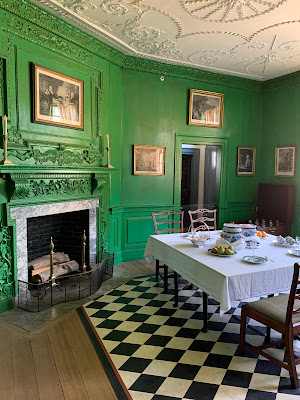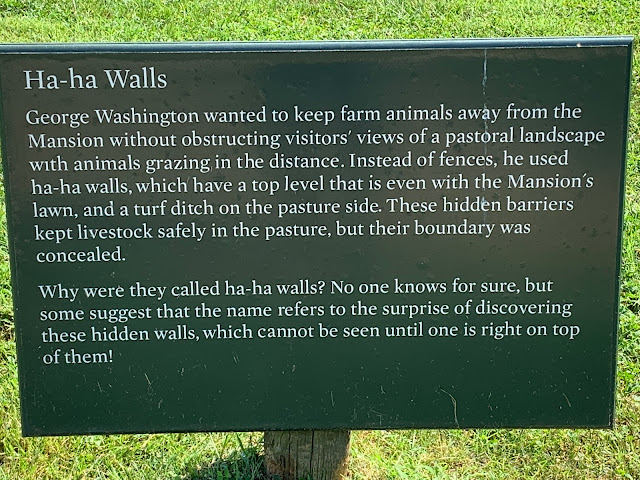We arrived at our next stop near Washington D.C. and headed to George Washington's Mount Vernon which is one of the most iconic 18th-century homes in America. The mansion is ten times the size of the average home in colonial Virginia.
hahahahaha
The walk from the parking lot was beautiful and, fortunately, we were there early so it wasn't too hot....yet.
The Visitor Center was beautiful and completely redone since we were last here.
This was a nice model of Mount Vernon.
We headed back outside - getting hotter - for a tour of the mansion.
Thankfully, we lined up for the tour under a tree so we got some relief from the hot sun.
We went into the first outbuilding and the guide explained to us how the house changed over the years.
The building began as a one and one-half story house built in 1734 by George Washington's father, Augustine Washington, and received its well-known name from his half-brother Lawrence Washington. George Washington began running Mount Vernon in 1754, and over the next 45 years slowly enlarged the dwelling to create the 21 room residence of today. Washington oversaw each renovation, advising on design, construction and decoration, despite being away much of the time. Conscious that the world was watching, Washington selected architectural features that expressed his growing status as a Virginia gentleman and, ultimately, as the leader of a new nation.
We then entered the house and our first stop was the biggest and grandest room of the house, what Washington called the "New Room". This room was intended to convey an emphasis on refined beauty and skilled craftsmanship, qualities he saw as communicating the new nation's values.
Washington also designed this room to be used for receptions and parties. With the table removed and chairs pushed back, there was plenty of space for dancing.
It's high ceiling and large north facing window made it an ideal picture gallery. The six large landscape paintings in the photo above are the original canvases that Washington acquired.
Ron and I wondered if the East Room of the White House was somehow inspired by the New Room at Mount Vernon. Obviously, the East Room is much grander in size but both seem to have been constructed to be more adaptable to several types of use. They are both to the left of the front entrance and is the only room in both structures where the ceiling is two-stories tall. Did Washington request this similar style in the White House? I guess we'll never know.
The central passage is the entry way into the Washington's home. Millions of visitors have placed their hands where George Washington placed his - on the handrail of this staircase.
An historic symbol of liberty, this key actually opened the main portal of the Bastille, the infamous political prison in Paris that was stormed at the outbreak of the French Revolution in 1789. The Marquis de Lafayette, who served under Washington during the Revolutionary War, sent him the key in 1790 enclosing this note "give me leave, My dear General, to present you With a picture of the Bastille just as it looked a few days after I Had ordered its demolition, with the [main key] of that fortress of despotism - it is a tribute Which I owe as A Son to My Adoptive father, as an aid de Camp to My General, as a Missionary of liberty to its patriarch". The key still hangs in the original case where Washington installed it.
The Front Parlor (below) was the main reception space for many of the Washington's guests. In 18th century Virginia, the parlor was the domain of the lady of the house and Martha Washington presided over her tea table here when performing this key social ritual.
In 1785, George Washington hired a plasterer artist, John Rawlins, to re-work the ceiling so it would match the one in the adjoining "New Room". With this change the Front Parlor became the formal entrance to that room.
When George Washington returned home from the presidency, he decided to convert what had been a first floor bed chamber into a music and family room, thus allowing more space for more informal entertaining.
In 1793, Washington ordered a top of the line harpsichord from London for his 14 year old step-granddaughter, Eleanor (Nellie) Parke Custis, a talented musician. The instrument here is a fully-working replica, completed in 2019 by John Watson of Williamsburg, Virginia. You will see the original harpsichord later.
The dining room is part of the original house which was started in 1734. Over the years the room underwent a series of renovations. While Washington was away in 1775, it was updated under the supervision of his cousin. In 1785, the bright green paint was added. Washington believed the color to be "grateful to the Eye" and less likely than other colors to fade.
In 1775, Washington decided to install an elaborately decorated plaster ceiling in the dining room in the same vein as the New Room and the Parlor. He hired an expert plasterer, identified simply as "the stucco man" who spent five months completing the hand-tooled ceiling. A renovation in 2001 uncovered some of the original pencil drawings on the ceiling, laying out the design.
The Blue Room was used as a bedchamber for visiting family and guests in the 1790s. Reproduction fabrics and wallpaper now represent the blue upholstery and wallpaper that gave the room its name.
Because the order was sent soon after Martha Washington moved to Mount Vernon, the highly fashionable bed was likely her choice. This was one of the many additions to the mansion's interior she made over time.
The portrait of the Marquis de Lafayette, commissioned by Washington and painted by Charles Willson Peale, was hung in the Lafayette room after the French Nobleman slept there during his 1784 visit to Mount Vernon.
Located in the private south wing of the second floor is George and Martha Washington's spacious bedroom. Designed according to Mrs. Washington's suggestion that it be simple and functional, the room was also her sanctuary where she planned her schedule and wrote letters to family and friends. According to her grandson, she also spent an hour each day reading the Bible and praying.
George Washington died of a severe throat infection in this room on December 14, 1799. Upon his death, Martha closed the room and for the remaining years of her life spent much of her time in a bed chamber on the third floor.
Directly below the Washington's bedroom was George Washington's private study. At the end of the Revolutionary War, the study became the place where he could retreat from ever present family and visitors and tend to business. Reportedly, no one was allowed in this room without his invitation.
The study was also where Washington bathed, dressed, and kept his clothes (closet door shown in photo below). Each morning he rose between 4:00 and 5:00 and went to the study using the private staircase that led down from the bed chamber.
In 1797, Washington sold the desk he used as President and bought a secretary (below) which was made in Philadelphia by John Aitken. The chair is a replica of the one in the museum - more on that later.
After Washington's father died, his half-brother, Lawrence, assumed the role of mentor to his younger sibling. Through him, Washington was introduced to some of Virginia's leading families and was able to learn and practice the social graces as well as further his career as a surveyor.
Lawrence Washington
It was time to move outside and view the back and side of the mansion. A lot of reconstruction going on.
A few interesting things to look at outside.
Here is the river below the ice house where they hauled the ice from.
I guess when you have many farm animals you have to worry about what to do with all of the "dung".
George Washington thought about his final interment.
And the "new" tomb......construction work caused the sarcophagi of George and Martha to be covered temporarily.
Remember the chair we saw at the secretary in George Washington's study?
The original chair used by two presidents
Three forensic models of George Washington depict him as the 19 year old surveyor, 45 year old general at Valley Forge, and 57 year old US President.
Depicting the first "First Lady" in a simple blue dress, white kerchief, and ruffled cap, this portrait embodies the matronly image of Martha Washington that persists in popular culture. This image likely stemmed from Mrs. Washington's preference for plain dress during her husband's presidency, a calculated choice meant to avoid accusations of ostentation. This painting was produced by Rembrandt Peale in the mid-19th century as a copy after Gilbert Stuart's 1796 portrait, which remains unfinished. Peale added the clothing and background.
When George Washington sat for painter Gilbert Stuart in 1796, the president consciously wore a black velvet suit rather than a military uniform or a monarch's robes, emphasizing his status as a civilian leader. This rendering inspired the likeness on the American one dollar bill. This is one of Stuart's many replicas of his original painting.
It's truly amazing how many new things you can discover about individuals when you have the time to study about their lives in depth. The Mount Vernon Society has certainly given visitors an opportunity to learn all they can possibly absorb about George and Martha Washington's lives.
* Much of the information in this post is from George Washington's Mount Vernon Official Guidebook. Best $10 I ever spent!














































No comments:
Post a Comment